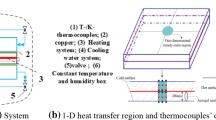Abstract
A mathematical model was developed to elucidate the interaction between transport/reaction processes and the evolution of porosity in chemical vapor infiltration with microwave heating (MCVI). The analysis included a set of partial differential equations describing the spatiotemporal variation of gaseous species concentration, composite temperature, porosity, and stress. Maxwell’s equations were used to determine the distribution of power dissipated inside the composite. The deposition of silicon carbide was selected as a model chemical system to explore the general features of MCVI. MCVI can provide a favorable temperature distribution in the composite yielding an inside-out deposition pattern, thereby preventing entrapment of accessible porosity. For this temperature profile, tensile stresses develop at the outer regions and compressive stresses are found in the composite core. For a given system there exists a minimum value of the coefficient for heat transfer from the composite surface, h, below which accessible porosity is trapped within the composite. Similarly, there exists a maximum value of the incident microwave energy flux, I0, above which accessible porosity is trapped within the composite. I0 and h can be optimized for a given preform to achieve complete densification with minimum processing time. Using the technique of pulsed-power, the processing time can be reduced even further without compromising density uniformity. Power dissipation profiles in the composite depend strongly on preform thickness, microwave frequency, and relative loss factor.
Similar content being viewed by others
Change history
03 March 2011
An Erratum to this paper has been published: https://doi.org/10.1557/JMR.1993.3251
References
J.A. Cornie Y.M. Chiang, D. R. Uhlmann A. Mortensen and J. M. Collins Am. Ceram. Soc. Bull. 65, 293 (1986).
J. R. Strife J.J. Brennan and K. M. Prewo Ceram. Eng. Sci. Proc. 11, 871 (1990).
M. A. Karnitz D. F. Craig and S. L. Richlen Am. Ceram. Soc. Bull. 70, 430 (1991).
T. M. Besmann R. A. Lowden B. W. Sheldon and D. P. Stinton in Chemical Vapor Deposition, edited by K. E. Spear and G. W. Cullen (The Electrochemical Society, Pennington, NJ, 1990), PV 90-12, p. 482.
W. H. Sutton, Am. Ceram. Soc. Bull. 68, 376 (1989).
Ceramic Transactions 21, edited by D. E. Clark F. D. Gac and W. H. Sutton (American Ceramic Society, Westerville, OH, 1991).
N.H. Tai and T.W. Chou, J. Am. Ceram. Soc. 73, 1489 (1990).
S.M. Gupte and J. A. Tsamopoulos J. Electrochem. Soc. 137, 3675 (1990).
S. Middleman J. Mater. Res. 4, 1515 (1989).
B.W. Sheldon J. Mater. Res. 5, 2729 (1990).
R. R. Melkote and K. F. Jensen in Chemical Vapor Deposition of Refractory Metals and Ceramics, edited by T. M. Besmann and B. M. Gallois (Mater. Res. Soc. Symp. Proc. 168, Pittsburgh, PA, 1990), p. 67.
S.V. Sotirchos AIChE J. 37, 1365 (1991).
D. Gupta and J.W. Evans J. Mater. Res. 6, 810 (1991).
J. I. Morell D. J. Economou and N. R. Amundson J. Elec-trochem. Soc. 139, 328 (1992).
J. I. Morell D. J. Economou and N. R. Amundson J. Mater. Res. 7, 2447 (1992).
J. A. Stratton Electromagnetic Theory (McGraw-Hill, New York, 1941).
G.A. Kriegsmann J. Appl. Phys. 71, 1960 (1992).
B.A. Boley and J.H. Weiner Theory of Thermal Stresses, 4th printing (John Wiley, New York, 1967).
R. Jackson Transport in Porous Catalysts (Elsevier Publishing Company, New York, 1977).
R. B. Bird W. E. Stewart and E. N. Lightfoot Transport Phenomena (John Wiley & Sons, New York, 1960).
R.R. Melkote and K.F. Jensen AIChE J. 35, 1942 (1989).
M. M. Tomadakis and S. V. Sotirchos AIChE J. 37, 74 (1991).
J. Schlichting Powder Metall. Int. 12, 141 (1980).
F. Langlais R. Naslain B. Tarride and C. Prebende J. de Physique SO, 93 (1989).
K. Brennfleck E. Fitzer G. Schoch and M. Dietrich in Proc. Int. Conf. on CVD, edited by M. Robison C.H.J. van den Brekel, G. W. Cullen J. M. Blocher Jr., and P. Rai-Choudhury (The Electrochemical Society, Pennington, NJ, 1984), Vol. 84-6, p. 649.
C. de Boor, A Practical Guide to Splines (Springer-Verlag, New York, 1978).
Author information
Authors and Affiliations
Rights and permissions
About this article
Cite this article
Morell, J.I., Economou, D.J. & Amundson, N.R. Chemical vapor infiltration of SiC with microwave heating. Journal of Materials Research 8, 1057–1067 (1993). https://doi.org/10.1557/JMR.1993.1057
Received:
Accepted:
Published:
Issue Date:
DOI: https://doi.org/10.1557/JMR.1993.1057



